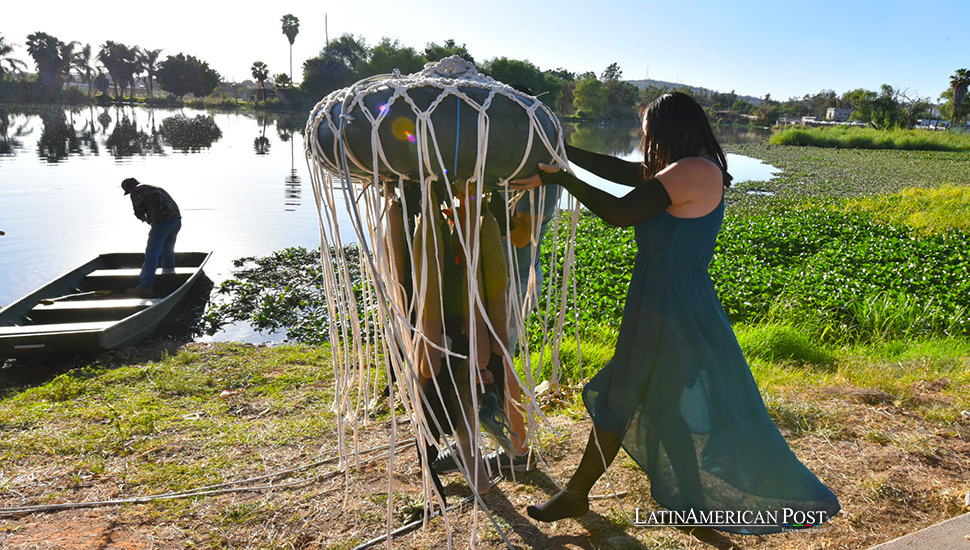Mexico Uses Human Hair to Battle River Pollution

Mexican activists and artists have launched a novel project called ‘Medusa,’ using human hair to cleanse the Santiago River, Mexico’s most polluted waterway. The project highlights a unique intersection of art, activism, and science in environmental conservation.
Artistic Activism: Unveiling the ‘Medusa’ Project
In a striking blend of environmental activism and artistic expression, Mexican activists and artists unveiled the ‘Medusa’ project, an innovative endeavor to tackle the pollution plaguing the Santiago River, Mexico’s most contaminated river. This initiative, which coincided with World Water Day, saw a human hair ‘jellyfish’ installation in the river, symbolizing a grassroots effort to address the environmental crisis.
The ‘Medusa’ project, spearheaded by artist Angélica Barba and activist Alitzel García Mayorga and supported by a collective of 50 stylists, activists, and academics, embodies a creative strategy to mitigate the river’s pollution. Socorro Vargas Jaramillo, the Museum of Environmental Sciences content coordinator, explained that the project involves a net-like structure crafted from yarn, featuring numerous ‘tentacles’ holding nylon stockings filled with 300 kilograms of human hair.
This initiative is deeply rooted in the local community, particularly among the inhabitants of Juanacatlán, who have witnessed the deteriorating condition of the Santiago River over the years. The hair ‘medusa’ was strategically placed near Juanacatlán’s boardwalk and is set to remain for two to three weeks. The choice of human hair is based on scientific evidence suggesting its potential to absorb pollutants, albeit in a limited capacity.
Scientific Analysis: Evaluating the Impact of the ‘Medusa’
After deployment, the hair will undergo biochemical analysis to identify the pollutants, heavy metals, and other substances it has absorbed from the river. Vargas Jaramillo shared insights into the anticipated research, highlighting the hair’s proven capability to soak up hydrocarbons and fats.
The contamination of the Santiago River and its impact on surrounding communities has drawn international attention, leading to the Inter-American Commission on Human Rights (IACHR) issuing preventive measures in 2020 to protect the rights of local inhabitants against irreversible harm due to pollution. Research conducted by various national and international entities has consistently shown the river’s contamination with heavy metals and other harmful substances, primarily from industrial activities along its banks, leading to increased rates of kidney disease and various cancers in nearby populations.
The ‘Medusa’ project in Mexico is part of a larger narrative unfolding across Latin America, where environmental challenges intersect with human rights and community activism. In regions like the Amazon Basin and the Andean highlands, communities face similar struggles against pollution and environmental degradation, often driven by industrial and mining activities.
Latin American countries increasingly recognize the need for innovative solutions to environmental issues, integrating local knowledge and scientific research to devise effective and sustainable strategies. The ‘Medusa’ project serves as a case study for the region, demonstrating how collaborative efforts can lead to practical and potentially transformative environmental interventions.
In Brazil, for example, initiatives to clean up the Tietê River involve modern technology and community engagement, mirroring Mexico’s ‘Medusa’ collaborative spirit. Similarly, grassroots movements have successfully advocated conserving water sources threatened by pollution and overuse in Colombia.
The Santiago River’s plight and the ‘Medusa’ project resonate with the broader environmental challenges faced by Latin America. These challenges highlight the region’s ongoing battle against pollution and the degradation of natural resources, underscoring the importance of innovative and community-driven solutions.
An Inspirational Movement
As the ‘Medusa’ project progresses, it represents a novel approach to environmental cleanup. It stands as a testament to the power of local activism and the potential for art to catalyze social and environmental change. The project’s outcomes and the data collected from the hair analysis will provide valuable insights into the effectiveness of such unconventional methods in combating pollution, offering potential pathways for similar initiatives in other contaminated waterways across Latin America and beyond.
Also read: Dissecting El Niño’s Impact on Mexico’s Marine Life and Beyond
The ‘Medusa’ project in Mexico’s Santiago River embodies a unique convergence of art, activism, and science, offering a fresh perspective on environmental conservation. As Latin American countries grapple with the dual challenges of protecting their natural resources and ensuring the well-being of their populations, initiatives like ‘Medusa’ highlight the innovative spirit and collaborative ethos essential for sustainable environmental stewardship in the region.




